
SOLAR MICRO GRID FOR OFF GRID LIGHTING IN VILLAGES
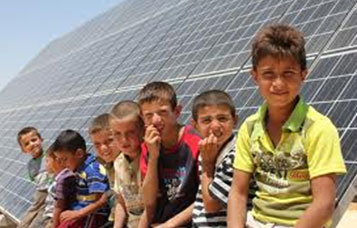
Case: 250households in a remote village will be electrified via a Solar Mini Grid located at the center of the village.
Introduction: “The poorest fifth of the world pay one fifth of the world’s lighting bill but receive only 0.1% of lighting benefits,” According to IEA statistics, 3 out of 5 people do not have access to basic electricity throughout the world. In India for example, 285 million people still don’t have access to Energy. 90% of these people live in our rural areas. 55% of our villages lack grid connection.
Most lack access to clean water, energy, and health services, either because the costs of extending these services are high; the motivation to do so is low, or both. As such, rural poor seeking access to these services and their accompanying opportunities face a choice between abandoning rural life (usually migrating to urban/peri-urban slums, where conditions are often no better) or making do with local alternatives.
Unfortunately, in rural areas where the traditional grid cannot easily be extended, the main energy alternative for electricity generation and water pumping is the diesel generator, which can harm both local air quality and the global climate
Such households ultimately resort to using inefficient, dangerous and dim Kerosene Lamps and Candles that are responsible for 50% of burn related injuries/deaths. A room lit by Kerosene and other fossil fuels can have concentrations of pollution 10 times the safe levels.
On an average, each household ends up spending Rs 100-200 pm (depending on household size) or 25-35% of their yearly income on buying Kerosene -> Kerosene Lamps -> Candles and other Lighting Equipments. This cost excludes the time spent on standing in queues for obtaining kerosene supplies, spilling kerosene on the way to the lighting point and study/work hours wasted by Children & Men.
Studies suggest that providing basic energy access can increase household incomes by 50% by providing more time & opportunities for Children to Study, Women to do house chores and Men to go to the farms and carry out businesses.
Situation in India
Rural Electrification (RE) has been in the focus of policy makers for the past several decades. However this policy priority has rarely translated into effective schemes on the ground. A combination of factors ranging from low tariffs, high cost to serve; poor efficiency levels and inappropriate organizational frameworks have led to continued neglect of rural India insofar as electricity services are concerned. Even within the overall levels of electrification in the country, the widespread regional disparities are a matter of genuine concern for policy makers and for the regulators. The Electricity Act, 2003 seeks to bring about a change in this picture. Section 6 of the Act mandates that the Government shall endeavor to supply electricity to all areas including villages and hamlets. Section 5 directs the Government to formulate a national policy (in consultation with the state Governments and states Commissions) for rural electrification and for the management of local distribution through Panchayats and other local institutions. Further Section 4 says that for setting up power generating plants in local area on a standalone basis no permission is required. As a part of the efforts of Govt. of India to achieve the goal “Electricity for All”, rural electrification has been identified as a major thrust area. For this purpose an “Accelerated Rural Electrification Project” for electrification of One Lakh Villages and One Crore Households was launched in February 2004 as a national program with an overall outlay of Rs. 6,000 Crores in which 40% was grant and 60% loan. The Central Government, in the last Finance Bill has enhanced the grant component to 90%. A plan for rural electrification – “The Rajiv Gandhi GrameenVidyutikaranYojana – has been launched to extend rural electricity services to hitherto un-electrified areas, with requisite additional funds provided for in the Union Budget.
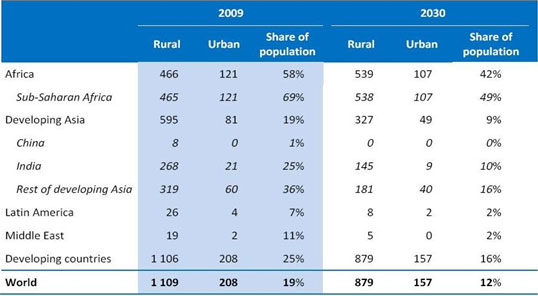
Indians are amongst the lowest consumers of power on the globe and yet a significant part of the rural population doesn’t even have a light bulb to brighten up their lives. Current costs of transmission, generation far outweigh the need for consistent access to electricity, a dream still, for most of the remote habitations in the nation. Their hope increasingly lies in Renewable Energy based solutions which are much less complex to install, operate and maintain.
Coal based thermal plants generate almost 50% of power nationwide and cause more than 70% of combined atmospheric pollution, with adverse local ecological impact and is harmful to humans. Less than 10% of the power that reaches consumers is truly from renewable energy sources, and no, we won’t consider nuclear as one of the contributors. The reasons; nuclear waste is extremely hazardous to all life and most power plants can’t withstand severe natural calamities, followed by their after effects, no matter the bravado i.e TEPCO, Chernobyl, several radioactive poisoning scares, inadequate response mechanisms, quality and other issues as
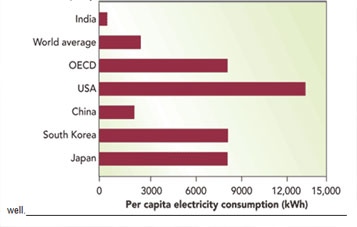
Exacerbating the power generation problem in India, is that for every KWh unit of power generated almost a third is lost due to our poor transmission and distribution infrastructure.
India has a current installed power generation capacity of 180 GW+ which translates into a loss of more than 60 GW worth of power generation. The power generation for the last fiscal was 811 Billion KWh Units as against a target of 830 BU a shortfall of just a little more than 2%.
Power utilities lose between Rs. 50,000 – Rs. 75,000 Crores annually on transmission and distribution inefficiencies as well as theft, more than enough to adequately feed more than 60 million poor annually. This in turn has a debilitating impact on the economics of inefficient Transmission and Distribution utilities, which are mostly bankrupt due to mismanagement as well as having to cater to political compulsions.
Renewable energy has only recently begun to gather steam with the launch of the Jawaharlal Nehru Solar Mission (JNNSM) by the Ministry of New and Renewable Energy (MNRE) which has set a challenging target of 20GW of Multi MW scale solar power plants to be connected to the grid by 2022. When the mission launched there were fewer than 10MW of solar power plants connected to the national grid. As of today approx. 80 MW is online and expected to multiply two hundred times that amount in little over a decade. The MNRE’s Strategic Plan For New And Renewable Energy Sector For The Period 2011-17 was also released in 2010,February with a view to promote renewable’s in a concerted fashion. The 12th plan for energy has renewed focus on alternate forms of energy with the shortfalls in coal quality and quantity plaguing the country.
- 80,000 + Villages
- 7,000,000 + Households
- 400,000,000 + Individuals
- Lack Connection to National Grid
Situation in Karnataka: Current Power Position
2.1 Institutional Structure
Electricity Generation and distribution in Karnataka has a history of over 100 years. The first generating station started operation in Shivanasamudram as early as 1902 (in the then State of Mysore) and was Asia’s first hydroelectric generating station. Generation in the State was entirely from hydroelectric power until Raichur thermal power station (RTPS) started operations in 1985. Even before power sector reforms were adopted in the rest of the country, the State had separate entities for generation and distribution. Karnataka Power Corporation Ltd. (KPCL), started in 1970 owned generation while the transmission and distribution networks were owned by Karnataka Electricity Board (KEB). In 1999, Karnataka Electricity Reforms Act was passed by the State legislature and led to major reforms in the power sector. Along with the corporatisation of KEB into Karnataka Power Transmission Corporation Ltd. (KPTCL), Karnataka Electricity Regulatory Commission (KERC) was also constituted in the year as an autonomous body to regulate all aspects of the power sector in the State. In 2002, KPTCL was further unbundled to form a transmission company as well as distribution companies with mandate for distribution and retail supply of electricity to consumers in the State.
Currently, the main entities in Karnataka’s power sector are the State-owned Karnataka Power Corporation Ltd. (KPCL) in generation, the State-owned Karnataka Power Transmission Corporation Ltd. (KPTCL) in transmission and five electricity supply companies (ESCOMs) – the Bangalore Electricity Supply Company (BESCOM), the Mangalore Electricity Supply Company (MESCOM), the Hubli Electricity Supply Company (HESCOM), the Gulbarga Electricity Supply Company (GESCOM) and the Chamundeshwari Electricity Supply Corporation Limited (CESC). Additionally, Hukkeri Rural Electric Cooperative Society (HRECS), the only cooperative society in the State with a distribution license, distributes power to consumers in Hukkeri Taluk and a few other villages in the area. The State Load Despatch Centre (SLDC), under KPTCL, performs the role of system operator with duties of real-time load despatch in the State’s power system.
In 2007, Government of Karnataka also set up a Special Purpose Vehicle (SPV) viz. Power Company of Karnataka Limited (PCKL). PCKL is responsible for procurement of power on behalf of all the ESCOMs in the State – both through long-term options like power purchase agreements (PPA), and short-term options like exchanges, banks and bilateral transactions.
2.2 Current status of supply, demand and shortages >/ Karnataka’s total installed generation capacity is 18,201 MW as on March 2013 (Table 1). This includes captive generation capacity of 35911 MW and renewable-based generation capacity of 4089 MW. Out of this, 12,605 MW has long term power purchase agreements (PPA) with the utilities (Table 2). A detailed list of thermal and hydro generating facilities supplying to the ESCOMs is available in Appendix 1.
Table 1: Installed capacity (as of Mar 2013) (MW) KPCL Thermal
- 2848
- KPCL Hydel 3671
- State share of CGS 1836
- IPP Thermal 21662
- Renewable Sources 4089
- Captive capacity 3591
- Total 18,201
Table 2: Installed capacity under long-term PPA with utilities (MW) KPCL Thermal
- 2848
- KPCL Hydel 3671
- State share of CGS 1836
- IPP Thermal 1080
- Renewable Sources 2820
- Captive 350
- Total 12,605
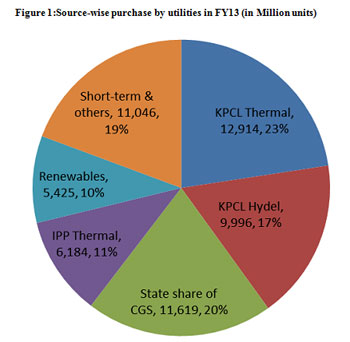
During FY13, the State saw an unrestricted demand of 66,274 Million kWh at utility bus bars and a peak of 10,124 MW. As against this, it was able to supply only 57,184 Million kWh and meet a peak of 8,761 MW. It is to be noted that the State regulator approved the purchase of 60,638 Million kWh for FY13 based on tariff applications of the ESCOMs. The demand calculated at utility bus bars after applying the below restrictions is defined as restricted demand:
a) 6 hours of 3-phase supply to agricultural pump sets
b) 24 hours of supply in Bangalore and 22 hours of supply in other urban areas
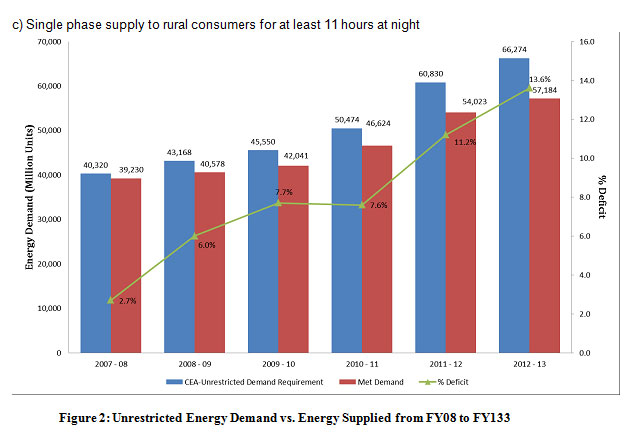
| Table 3: Current features of Karnataka's Power Sector (FY13) Installed capacity (under long term PPA with utilities) | 12, 605 MW |
|---|---|
| Unrestricted demand | 66, 274 Million kWh |
| Restricted demand (approved by the Commission) | 60, 638 Million kWh |
| Annual energy demand met (FY13) | 57, 184 Million kWh |
| Deficit on approved demand | 5.7% |
| Deficit on unrestricted demand | 13.7% |
| Peak requirement (FY13) | 10, 124 MW |
| Peak met (FY13) | 8, 761 MW |
| State | Domestic | Commercial | Industrial( LT) | Industrial (HT) | Agriculture | Others |
|---|---|---|---|---|---|---|
| Karnataka | 19% | 11% | 4% | 29% | 31% | 6% |
| Gujarat | 13% | 6% | 12% | 47% | 19% | 3% |
| Maharashtra | 21% | 13% | 8% | 35% | 18% | 6% |
| Andhra Pradesh | 20% | 7% | 4% | 36% | 26% | 7% |
| Tamilnadu | 24% | 9% | 9% | 34% | 18% | 6 |
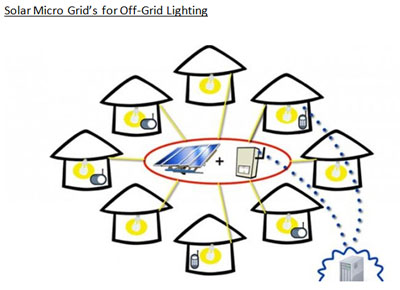
Mini-grids, or Microgrids, depending on one’s own personal preference in terminology, have arguably been the fastest changing, most dynamic aspect of the global energy system over the past several years. What started as an interesting set of tremendously diverse and largely locally unique cases of small (systems up to roughly 100 kW, although the range of definitions rivals the number of such systems) has become scientifically, technically, politically, organizationally, and socially a true hot-bed of innovation. Micro-grids are popping up all over the world, from systems that can connect or disconnect from larger main’ grid systems, to tiny, informally wired connections between very few users. Some remarkable success stories exist – from high-altitude communities in Nepal anchoring increasingly sophisticated local grids around mountain streams, to solar and biomass powered oases of energy access in rainforests around the globe, to areas in East Africa, India, and the U. S. and Russian arctic that are finding that the reliability, rapidity of development, and flexibility of microgrids makes them ideal resources to improve the quality of life and promote development in areas not slated for large-scale energy connectivity for decades.
These microgrids are building on increasingly modular natural and bio-gas combusting turbines, solar, wind, biomass, hydro and geothermal generation technologies that are improving rapidly in cost and performance. This technical evolution is made all the more exciting by changes in networking technology – both for power management and end-user service, and in the increasingly critical information technology sphere that enables improved billing, load management and remote diagnostics.
All of these changes mean than Microgrids are now evolving at a blinding pace, with new technologies and new applications and new companies appearing literally daily. In East Africa new, entirely mobile- phone based banking has changed the financial face of Kenya, with other nations developing their own versions.
In the easiest of words, Micro-Grids are nothing but normal electricity supply utilities that are powered by Solar Energy and not conventional sources of Energy. They’re connected to households like normal power meters and can be used exactly like the power meters that are used by customers across India. Micro Grids differ with normal power meters in many ways;
- They can be designed as per each households dynamic power need and does not have to be standardized.
- They are powered by cleaner sources of Energy like the SUN.
- Pay As You Go systems can be used that work on the same principle of mobile recharges. Get energy equivalent to the amount of money deposited.
Model
Villages and towns that are far from the utility grid can have their electricity needs met by autonomous micro-grids which can integrate wind, solar, diesel, and other energy sources to create a robust and reliable local grid. For customers, this source of energy operates just as if they were connected to the national utility: they pay a monthly fee based on their consumption. These micro grids are controlled by Automatic Controllers that are programmed by developers to allow for usage and meet demands of consumers as per the agreement between the developer, buyer, micro entrepreneur and the user. When structured correctly, micro-grid projects can present a sustainable model for community electrification, with operating and maintenance costs covered by revenue from the metered customers. The micro-grids also offer an attractive return on investment for the operator of the system.
In this case, we will be installing a central Micro Grid in a village that comprises of 250 households. Assuming a distance of 40-80 meters between the central micro grid and each consuming household, each household will be supplied with power that can run 1 x Ceiling Fan + 1 x Tube Light + 1 x CFL and charge mobiles. All of these are existing appliances in each household and need not be replaced with DC appliances as is the case with traditional micro grids.
Each household will be allowed to use the above appliances for 8 hours in the day and 4 hours in the night.
Micro Entrepreneur
A micro entrepreneur (ME) is a local village based individual who acts as the last mile to reach consumers, thus improving access for the low-income population to diverse products by taking on market innovations at the grassroots level. The word “entrepreneur” should be understood in the social context of where these individuals operate. They are small business persons who have decided to be an agent of certain goods and services to augment their income.
These MEs act as a bridge between the consumers of power product from Micro Grids and their developers. As such MEs are in charge of collecting fees from users for energy used by them on a monthly basis and passing it on to the developer.
MEs might be salaried employees of the developer or + and may be appointed as caretakers of Micro Grids to the extent of collecting fees + undertaking O&M and earning a commission for the same.
User’s of Micro Grids
As mentioned, each household will get access to 12 hours of lighting (8 hours in the day + 4 hours in the night) through their existing AC appliances like Ceiling Fan, Tube-light, CFL and mobile charger.
In other words, 250 households will get 150W of power which can be used by them in any way for running any kind of appliances till the total load does not exceed 150W. As an example, refer to the below table for load consumption of standard appliances;
| Appliance | Wattage (Consumed) |
|---|---|
| Ceiling Fan | 80W |
| Tube-Light | 40W |
| CFL | 30W |
| TV of up to 22 inches | 120W |
| Small Fridge | 150W |
| Cooler | 180W |
The user will be charged a monthly fee just like in the case of an electricity bill which will be collected by the micro entrepreneur in-charge of the village which will ultimately go to the developer of the Grid.
Failure to make timely payment will result in temporary or permanent cut in Energy Supply.
With the national goal of providing 150 villages p.a. with access to electricity in order to achieve a rural electrification rate of 30-40 % by 2015, it has become inevitable for the country to turn to Renewable Energy sources like Solar Energy for which promotion of Sustainable & Innovative community based systems is a must.
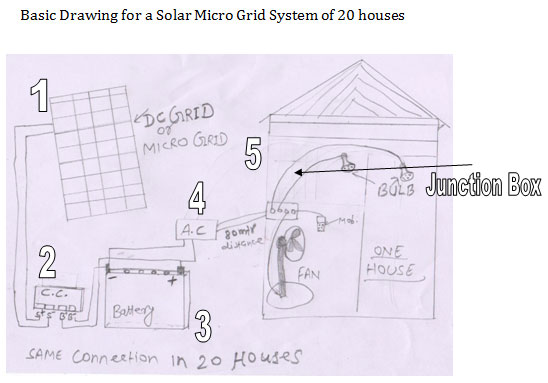
INSTALLATION DESCRIPTION
1. DC Micro grid wires (yellow and blue) labeled 1 is connected with C.C (Charge controller) or Solar PCU unit labeled 2.
2. Battery positive (Red) and negative (Black) labeled 3 is connected with C.C or Solar PCU unit (labeled 2) .
3. Battery positive and negative is connected with A.C (Automatic controller) labeled 4. .
4. 250n (1 Ceiling Fanx 1 Bulbs +1 xTube-Light + 1 x Mobile Charger) is connected with A.C to control the working hour, 4 hours in night and 8 hours in day..
5. All connections will be through Junction Box, and same connection will be in 250 houses with 40-80 meter distance covered. .
AUTOMATIC CONTROLLER(A.C)CONTROLS THE OPERATING HOURs AS YOU WANT..
Key;
1: Central Solar Micro Grid.
2: Charge Controller.
3: Battery, Positive (Red) + Negative (Black).
4: Automatic Controller: Controls usage and working time in every household the way you want. We can adjust this. .
5: Each individual house.
20n refers to number of households. 20 houses in this case
Assumptions
1: Assuming the Solar Micro Grid to be built centrally in a village, each household is assumed to be at a distance of 40-80 meters away from the central grid.
2: With reduced distance between the grid and the houses, transmission & distribution losses will be curtailed, wiring costs will be reduced and hence the total costs will reduce..
3: Each ceiling fan is assumed to be of 80W.
4: Each CFL is assumed to be of 27-30W.
5. Each Tube-Light is assumed to be of 40W.
References & Findings
1: Microgrids for Rural Electrification: A critical review of best practices by Daniel Schnitzer.
2: International Energy Agency .
3: Bennu Solar, Bennu Value.
4: RiteshPothan, Natural Group .
5: World Bank resources.
6: Justin Guay, Sierra Club.
7: Ernst & Young report dated March,2007.
8. CSTEP Karnataka Power Sector Roadmap Report, 2013.
